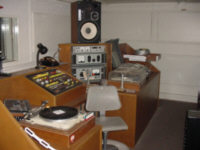Accommodation
Archaeology
Articles and reviews
Arts
Art for sale
Scottish Books
Calendars
Castles and Historic Houses
Famous Scots
Family/Genealogy
Gaelic/Language
Golf
Home Page
Humour
Museums & Attractions
News and Breaking Stories
Picture Gallery
Places to visit
Poster Store
Privacy Statement
Quizzes and puzzles (Fun Only)
Recipes
Small Ads
Site Map
Whisky
Links
REVIEW of ATTRACTION 2001
After the Second World War, relations between the former allies of East and West became strained. This situation known as the Cold War, escalated to such an extent that Britain built a series of bunkers to act as early warning of a nuclear attack, all along its East Coast. This was one of them and until recently was still covered by the Official Secrets Act.
However, Scotlands secret bunker is now open to whoever wants to visit (and pay the entrance fee of course!)
This attraction is in some ways a strange place to visit, especially if you start to think about its original purpose. The attraction is entered via, as the advertising blurb puts it, an innocent looking farmhouse and from there you enter the facility via a 150 metre long tunnel made of three metre thick concrete.As you travel down this corridor you hear the sounds of a families being ushered down the hallway. However as you make your way around the attraction it becomes increasingly obvious that unless you were essential to the nations survival after a nuclear attack, you would not be one of these people being ushered down the hallways.
That said however, the attraction is worth visiting if you can put this strange and eerie sensation to the back of your mind. The attraction consists of two levels, which are open to the public. The first level consists of mock-ups of rooms, as they would have been during the time that the bunker was in service. This includes dormitories (no room for privacy here- hot bed system- if you're not in it someone else is), the B.B.C. broadcasting studio

and the coffee shop, which is based in the former canteen. On the subject of the coffee shop, I am happy to report that when we visited (20 May 2001), the food was actually reasonably priced and of a decent standard- I'll say no more.
On this floor is also a room dedicated to the Royal Observer Corps. Whilst it is made clear that they wouldn't have served at the bunker, they would have provided vital information to those who did. Their main duties were to provide information on the level and intensity of nuclear blasts and radioactive fallout (do I hear any volunteers for that job?)
The second floor provides further insight into what life would have been like in the bunker. The first room is a mock-up of an R.A.F. operations room from the 1950's, which monitored the frequent incursions into NATO airspace by the Warsaw Pact countries. A communications centre which was the vital link to the outside world from the safety of the bunker, the plant room which houses (the still operational) air filter system and the Central Government and Nuclear Operations room. In addition to these displays are also a small armoury, Civil Defence Corps display and an exhibition by C.N.D. (the campaign for nuclear disarmament)
As I said earlier it is a slightly unnerving experience but an interesting one nonetheless. It is a well-laid out exhibition, with many interesting facts, well laid out information boards and authentic examples of artefacts from the time period. My only minor gripe is more of a plea. The models, which the attraction uses instead of people, look like those you would have found in a shop window in the 1950's. Spoils the effect a little.
For Further information:
Scotland's Secret Bunker
Crown Buildings
Troywood
Nr St Andrews (I would actually say it is nearer Anstruther)
Telephone 01333 310301
Fax 01333 312040